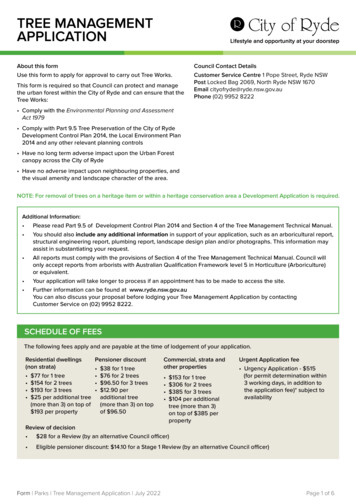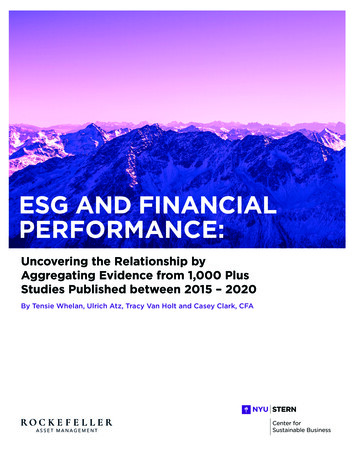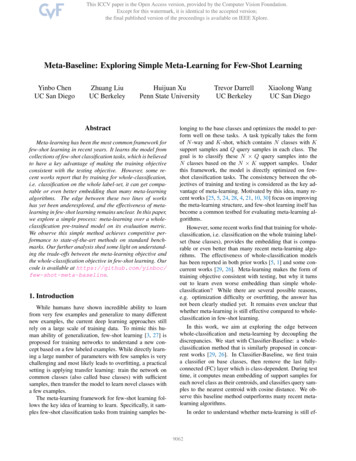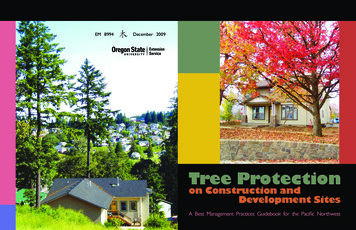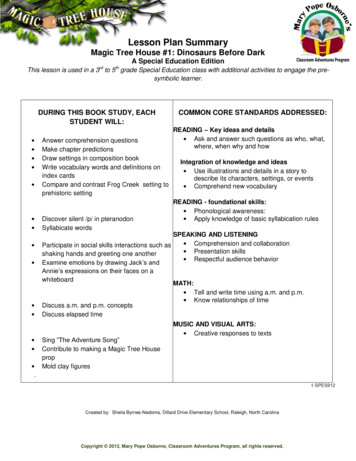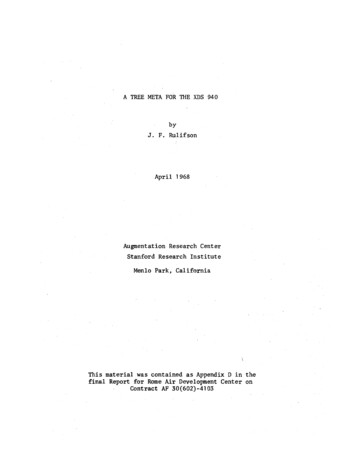
Transcription
A TREE META FOR THE XDS 940byJ. F. RulifsonApril 1968Augmentation Research CenterStanford Research InstituteMenlo Park, CaliforniaThis material was contained as Appendix D in thefinal Report for Rome Air Development Center onContract AF 30(602)-4103
APPENDIX 0 -- TREE META:Introduction1 Terms such as "metalanguage" and "metacompiler" have a varietymeanings. Their usage within this report, however, is well defined.oflA "Language," without the prefix "meta," means any formal computerlanguage. These are generally lanRuagcs like ALGOL or FORTRAN. AnymetalanRauge is also a language.IB . A compiler is a computer program that reads a formal-languageprogram as input and translates that program into instructions thatmay be executed by a computer.The tcrm "compiler" also means alisting of the ins.tructions of the compiler.Ie A language that can he used to describe other languages is ametalanguage.English is an infonnal, general mctalanguage that candescribe any formal language.Backus-Naur Form or BNF (Nurl) is afonnal metalanguage used to define ALGOL. BNF is weak, for itdescrihes only the syntax of ALGOL, and says nothing about theseJ:lantics or meaning. English J on the other hand, is powerful, yetits informality prohihits its translation into computer programs.InA mctacornpi ler, in the mos t general sense of the term, is aprogram that reads a metalanguage program as input and translatesthatpror,ram into a set of instructions.If the input program is acomplete description of a fomal language, the translation is acompiler for the language.2 rn,e broad meaning. of the \'lord "metacompi ler, " the st rang, divergentviews of many people in the field, and our restricted e of the wordnecessitate a fonnal statement of the design standards and 5cope of Tree 1eta.2A Tree ta is built to deal with a specific set of languages andan even more specific set of users. TIlis project, therefore, add5 tothe ever-increasing problem of the proliferation of machines andlanguages, rather than attempting to reduce it. There is no attemptto design universal languages, or machine independent languages, orany of the other goals of many compiler-compiler SY5tems.Compiler-compiler systems may he rated on two almost independentfeatures: the syntax they can handle and the features wi thin thesystem that ease the compiler-building process.2BTree Ieta is i.ntended to parse context-free laguages usinglimi ted hackup. There is no intent or desire on the part of theusers to deal with such problems as the FORTRAN "continue"statement, the PL/I "enough end5 to match," or the ALGOL "i5 itprocedure or is it a variable" question. Tree Heta is only onepart of a system-bui lding technique. There is flexibi 1i ty at alllevels of the system and the design philosophy has been to take2B1D-1
APPENDI X n -- TREE fETA:Introductionthe easy way out rather than fiRht old problems.2B.2Manyofthefeaturesconsiderednecessary for acompiler-compiler system arc absent in Tree M a. Such things assymbOl-tables that handle ALGOL-style blocks and variable typesare not included. Neither are there features for multidimensionalsubscripts or higher level macros. These features are not presentbecause the users have not yet needed them. None, however, wouldhe difficult to add.2B3 Tree Meta translates directly from a high-level language tomachine code. This is not for the faint of heart. There is avery . smallnumberofusers (approximately 3); allaremachine-language coders of about thesamehi hlevel ofproficiency.TIle nature of the special-purpose languages dcaltwith is such that general fonnal 5ystems will not work. The datastructures and operations are too diverse to produce appropriatecode with current state-of-the-art formal compiling techniques.3 There are two classes of formal-definition compiler-writinf! schemes.3A In terms of usage, the productive or synthetic approach tolanguage definition is the most common.A productive p,rammarconsists primarily of a set of rules that describe a method ofgenerating all the possible strings of the language.38TIle reductive or analytic techni'lue 5tates a set of rules thatdescribe a method of analyzinr. any string of characters and decidinrwhether that string is in the lanp,uage. This approach simultaneouslyproduces a structure for the i.nput strinp. so· that code may hecompilcd.3CThe metacompilers arc a combination of hath schcJTles. They areneither purely productive nor purely reductive, hut merge hothtechniques into a pm."erful \vork i.ng system.4 The netacompiler class of cOl'lpiler-compilersystemsmayhecharacterized by a common top-down parsinp; algorithm and a commonsyntax.These· compilers are expressible in their own language, whencethe prefix "meta."4AThe following is a formal discussion of t.op-dOl."n parsingalgorithms. It reliesheavily on definitions and fonnalisns whichare standard in the literature and may be skipped by the lay reader.For a language L, Kith vocabulary V, nonterminal vocahlliary !':.productions P, and head S, the top-down parse of a 5tring u in Lstarts \vi th S and looks for a sequence of product:i ons such that S u(S produces u).D-2
APPENDIX n -- TREE4Al TA:IntroductionLet V[E,N[E,p [E. - r ,··.- F /F · .- X /(V,N,P,E)TL T, F,T, FJ* , (,),X)/ T FF * T( E )4A2The follo\ving inten tionaily incomplete ALGOL procedures wi IIperform a top-down analysis of strings in L.4A2Aboo lean procedure E; E: if T then (i f issymhol (' ' )then E else true) else false; comment issymbol (arp,) is aBoolean p.rocedure that compares the next symbol in the inputstring with its argument, argo If there is a match the inputstream is advanced;4A2Rhoolcan procedure T; T .- if F thenthen T else true) else false;(ifissymbol('*')4A2C boo lean procedure F;F : if issymbol (' X') then trueelse if issymbol('(') then (if E then (if issymbo1(')') thentrue else false) else false) else false;4A3 TIle· left-recursion problem can readily be seen by a slightmodification of L. Change the first production toE :: T / E T·and the procedure for E in the corresponding way toE : if T th en true e Is e if E 4A3A Parsing the string "X X", the procedure E will call T,\vhich calls F, which tests for "X" and gives the result "true."E is then true hut only the first element of the string is inthe analysis, and the parse st·ops before completion. I f theinput string is not a member of the language, T is false and Eloops infinitely.4A3B TIle solution to the prob lem used in Tree Heta is thearbi trary number operator. In Tree Heta the first productioncould beE :: T ( " " T)where the dollar sign and the parentheses indicate that thequantity can he repeated any nUMb r of times, including O.4A3C Tree rlcta makes no check to ensure that the compi ler itis pr ducing lacks syntax rules containing left recursion.This problen is one of the more common mistakes made byD-3
APPEND! Xn -- TREE 1ETA:Introductioninexperienced metalanguage programmers.The input langua e to the metacompiler closely resembles BNF.The primary difference between a BNF rule go to :: o to lahel and a metalanguage ruleGOTO "GO" "W" .ID;is that the metalanguage has been desi ed to use a sicentities.TIlearbi trary-number operator and parenthes isconstruct ionof the'metalanguage are lacking in BNF. For example:4BTERH FACTOR (("." / "/" / 'm) FACTOR);is a metalanguage rule that would replace 3 BNF rules.4C The ability of the compilers to he expressed in their ownlanguagc has resulted in the proliferation of metacompiler systems.Each one is easily bootstrapped from a more primitive version, andcomplex compilers are built with little pror.;ranuning or debuggingeffort.5 The early history of metacompilers is closely tied to the history ofSIG/PLAN Working f;roup 1 on Syntax Driven Compilers.'Ine group wasstarted in the. Los Angles area primarily through the effort of Howard fetcal fe (Schmidt 1) SAInthe fall of 1962, he designed twocompiler-writinp.interpreters (Netcalfl). One used a bottom-to-top analysis techniCluebased on a method described by Ledley and Wi lson (Ledleyl). Theother used a top-to-hottom approach based on a ,"ork by f,lennie(Glenniel) to generate random English sentences from a context-freegranunar.58 At the same time, Val Schorre described two ''met amach i nes"--onegenerative and one analytic. TIle enerative machine was implemented,and pro uced random al gebraic express ions. Schorre imp lemented tetaI the first metacompiler, on an IB 1 1401 at UCLA in ,January 1963(Schorrel). His original interpreters and metamachines were writtendirectly in a pseudo-machine lanr,uage. rfeta I, however, \tIas writtenin a higher-levelsyntaxlanguage ah Ie to describe its owncompilation into the pseudo-machine languag(". Heta I is described inan Wlavailable paper given at the 1963 Colorado ACH conference.SCLee Schmidt at Bol t, Beranek, and Newman wrote a metacompi ler in1963 that uti Ii z.ed a CRT display on the time-sharing PIJP-l(Schmidt2). This compiler produced actual machine code rather thaninterpret i ve code and \Vas part i ally bootstrapped from ·1eta I. 1arch.(, Schorre bootstrapped r,teta I I from rteta I during the Sprinr. of 1963(Schorre2). The paper on the refined metacompiler systempresented atD-4
APPENDIX 0 -- TREE ffiTA:Introductirinthe 1964PhiladelphiaACM conference is the first paper on ametacompiler available as a generalreference.The syntax andimplementation technique of Schorre's system laid the foundation formost of the systems that followed.Again the system was implemented ona small 1401, and was used to implement a small ALGOL-like language.7 1anysimIlar systems immediately followed.7A Roger Rutman of A. C. Spar},plug developed and implemented LOGIK.a language for logical desir.n simulation, on the IBH 7090 in January1964 (Rutman!).This compiler used an algorithm that producedefficient code for Boolean expressions.7BAnother paper in the 1964 ACM proceedings descrihes ta III,developedhy chneider and Johnson at UCLA for the IBH 7090(Schneiderl).Heta III represents an attempt to produce efficientmachine code, for a large class of languages.It was implementedcompletely in assembly language. Two compilers were written in MetaIII--COnOL, a compiler-wrjting demonstration compiler, and PtJREGOL,a dialect of ALGOL 60. (It was pure gall to call it ALGOL). Therumored fETAFORE, ab Ie to compi Ie full AU;OL, hasnever beenannounced.7CLate in 1964, Lee Schmidt bootstrapped a metacompiler from thePDP-l to the Beckman 420 (Schmidt3) It was a logic equationgenerating language known as EQr,EN.8 Since 1964, System Development Corporation has supported a majoreffort in the development of metacompilcrs.This effort includespowerfulmetacompi lerswri tteninLISPwh ichhave extensi vetree-searching and backup capability (Bookl) (Book2).9 An outgrowth of one of the Q-32 systems at snc is 1eta 5 (Oppenheim!)(Schaffer!) Th is system has been success fully released to a widenumber of users and has had many strin -manipulation applications otherthan compil ing. The 1eta 5 system incorporates backup of the inputstream and enough other facilities to parse any context-sensitivelanguage. It has many elaborate push-down stacks, attrihute setting andtestinp: facilities, and output mechanisrn.c;.The fact that 1eta 5success fullytrans lates TOVIAL programs to PL/l programs clearlydemonstrates its power and flexihility.10 The LOT system was developed during 1966 at Stanford ResearchInstitute and was modeled very closely after 'eta II (Kirkleyl). It hadnew special-purpose constructs allowing it to generate a compiler whichwould in turn he ble to compile a suh et of PL/l. This system hadextensive statistic-gatherinr facilities and was used to study thecharacteristics of top-down analysis. It also embedded system control,normally relegated to c()ntrol cards, in the. metalanguage.D-5
APPENDIX 0 -- TnEE IF.TA:Introuuction11 The' concept of the. metarnachine originally put forth5imple that three hardware versions have been designedimplemented. TIle latter at Nashington University inmachine lias built from macromodular components and hasthe codes described by Schorre (Schorre2).D-6hy Cllennie is soand one actuallySt. Louis. Thisfor instructions
APPEND! Xn . -TREE mTA:Basic Syntax12 A netaprogram is a set of mctalanguages rules. Each rule has theform of a BNF rule, with output instructions embedded in the syntacticdescription.12.\ The Tree teta comp ler converts each ofinstructions for the computer.therulesto a set of12BAs the" rules (acting as instructions) compile a program, theyread an input st rerun of characters one character at a time. Each newcharacter is subjected to a series of tests until an appropriatesyntactic description" is found for that character.The nextcharacter is then read and the rule testinr. moves forward throup.h theinput.13The following four rules illustrate the hasic "constructs in thesystem. They will he referretl to later by the reference numhers RIAthrough R,lA.RIAEXP TEJU1R2A11:R fR3AFACTOR'R4AC" "EXPI "-" EXP I .EHPTY); FACTOR C"*" FACTOR It "PRI ·1 II IFACTOR NtJ 1I "I" FACTOR);I PRIH;I n(" EXP ")";13AThe identifier to the left of the initial equal sir,n names therule. This name is used to refer to the rule from other rules. nlename of rule RIA is EXP.TIle right part of the rule- . everythinr. hetween the initial equaland the trailing semicoIon--is the' part of the rule whicheffects the scanning of the input. Five hasic types of entities mayoccur in a rir;ht part. Each of the entities represents some sort ofa test which results in setting a general flag to Either "true" orBfaIse".13Bsi n13B1A string of characters betweenquotationmarks C")represents a literal string.These literal strings are testedagainst the input stream as characters are read. "1332 Rule names may also occur in a right part.If a rule isprocessing inTlUt and a name is reached, the named rule is invoked.R3A defines a FACTOR as being either a minus sign followed by aFACTOR, or just a PRI f.13113 The right part of the rule FACTOR has just been definelt as"a string of elements," "or" "another strinp, of elements." nleD-7
APPENDIXn --TRRE ffiTA:Basic Syntax"or's" are indicated'by slash marks (/l and each individual stringis called an alternative. Thus, in the above example, the minussign and the rule name FACmR nre two elements in R3A. These twoelements make up an alternative of the rule.13B4 The dollar sign is the arbitrary number operato:r in theJnetalanguage. A dollar sign must be followed by a single element,and it indicates that this element may occur an arbitrary numberof times (including zero). Parentheses may be used to group a setof elements into a single element as in RIA and R2A1385 The final basic entities may be seen in rule R4A. Theserepresent the basic recognizers of the metacompiler system.A.basic recognizer is a program in Tree." '1eta that may be called uponto test the input stream for an occurrence of a particular entity.In Tree leta the three recognizers are "identifier" as - .ID,"nwnher" as .NWf, and "string" as .SR. There is another hasicentity tha is treated as a recognizer but does not look foranything. It is .E 1PTY and it always returns a value of "true."14rxpSuppose that the input stream contains the string X Yis invoked during a compilation.,,fhen the rule14A UXP first calls rule TER t, that calls FACTOR, that tests for aminus sign.111is test fails and FACTOR then tests for a plus sirnand fails ar.ai n. Finally FACTOR' calls PRHl, that tests for anidentifier. The character X is an identifier; it is recognizeJ andthe input stream advances one character.14B PRH1 returns a value of "true" to FACTOR, which in tum returnsto TERH. TERr·1 tests for an astcrisk and fails. It then tests for aslash and fails. The dollar sign in front of the parenthesized groupin TER 1, howcver, means that the rule has succeeded because TEm·1 hasfound a FACTOR followed by zero occurrences of "asterisk FACTOR" or"slash FACTOR." Thus TERr·, returns a "true" value to EXP. EXP nowtests for a plus sign and finds it. The input stream advancesanother character.14C EXP now calls on itself.All necessary information is saved sothat the return may he made to the right place. In calling on itself,it goes through the sequence just described until it recognizes theY.Thinkin!,! of the rules in this \'1ay is confusing and tedious. Itis best to think of each rule separately. For example: one shouldthink of R2A as Jefining a TI:R 1 to be a series of FACTORs separatedhy asterisks and slashes and not attempt to think of all the possihlethings a FACTOH could be.14JlD-8
APPENDIX D -- TREE mTA:Rasic SyntaxIS Tree feta is different from most metacompiler systems in that ithuilds a parse tree of the input stream before producing any output.Before we describe the syntax of node generation, let us first discussparse trees.l?A A parse tree is a structural description of the input stream interms of the given grammar.lSAlUsing the four rules above, the input streamx y*zhas the following parse treelSA2 In this tree each node is either the name of a rule or oneof the primary entities recoGnized hy the basic recognizerroutines.lSA3In this tree there is a great deal of subcater.orization.For example, Y is a PRI 1, which is a FACTOR, which is the leftmemher of a TErt 1. 'nlis degree of subcater.orization is 'generallyundesirahle.ISH The tree produced by the l1letacompiler program is simpler thanthe one above, yet it contains sufficient information to complete thecompi 1 at ion. D-9
APPENDIX 0 -- TREE1581 mTA:Basic SyntaxThe parse tree actually produced isyz1582In· this tree the names of the nodes are not the rule namesof the syntactic definitions, but rather the names of rules thatwill be used to generate the code from the tree15B3 The rules that produce the above tree are the same as thefour previous rules with new syntax additions to perfonn :RlBEXP TER 1 (" " EXP :ADD/R2HTER f FACTOR" ItI:XP :SlJB) [2) (("*" FACTOR : nJLT/"I".E tPTY);FACTOR :DIVn)[2]) ;fACTOn :NINtJS·[lJ /R3BFACTOR " "R4BPRIrt .ID / .NUH / "(" EXP ")";PRI i';ISCAs these rules scan an input stream, they perform just like thefirst set. As the entities are recognized, however, they are storedon a push-down stack until the node- eneration clements remove themto make trees. We will step through these rules with the same sampleinput stream:x·y*z15Cl EXP calls TERr.t, which calls. FACTOR, which calls PRI 1, whichrecognizes the X The input stream moves forward and the X is puton a stack.15(2 PRH·t returns to FACTOR, which returns to TER 1, which returnsto EXP. The plus sign is recognized and EXP is again called.Again EXP calls TER l, which calls FACTOR, which calls PRHf whichrecognizes the Y. The input stream is advanced, and Y is put onthe push-down stack.The stack nO\\1 contains Y X, and the nextcharacter on the input stream is the asterisk.D-IO
APPENDIX DTREE META:Ba icSyntax15C3 PRIM returns to FACTOR, which returns to TERM. The asteriskis recognized and the input is advanced another character.15C4The rule TERM now calls FACTOR, which calls PRIM, whichrecognizes the Z, advances the input stream, and puts the Z on thp.push-down stack.15(5The : ruLT in now processed.This names the next node tobe put in the tree.Later ''Ie will see that in a completemetacompiler program there will be a rule named 1ULT which will beprocessed when the time comes to produce code from the tree.Next, the [2] in the rule TERM is processed. This tells the systemto construct a portion of a tree. The branch is to have twonodes, and they are to be the last two entities recognized (theyare on the stack). The name of the branch is to be 1ULT, sincethat \vas the last name given. The branch is constructed and thetop two items of the stack are replaced hy the new node of thetree.15C5ATIle stack now contains ruLTxl5C5BThe parse tree is now YZ15C5'C Notice that the nodes are assemh led in a left-to-rightorder, and that the original order of recognition is retained.15C6 Rule TER ·1 now returns to EXP which names the next node hyexecuting the :ADOi.e., names the next node for the tree.TIle [2J in rule EXP is nO\" executed.A branch of· the tree isgenerated that contains the top two items of the stack and whosename is ADD. The top two items of the stack arc removed, leavingit as it was initially, empty. The tree is now complete, as firstshO\.;n, and all the input ·has heen passcJ. over.16 The unparsinr, rules have two functions: they produce output and theytest the tree in much the same \ Jay as the parsing rules test the inputstream. 111is testinr, of the tree a!m Js the output to he hascd on thedeep structure of the input, and hence hetter output may be nroduced.D-ll
:\PPENDIX n -- TREE rfETA:Rasle Syntax16ABefore we discuss the node-testing features, let us firstdescribe the various types of output that may be produced. ThefollmlTing 1 ist of output-generation features in the metacompi lersystem is enough for most examples.The output is line-oriented, and the end of a line is16A1To instruct the system todetermined by a carriage return.produce a carriage return , one writes a hacks lash (upper-case L ona Teletype) as an clement of an unparse rule.16A2 To J11ake the output moreTo put n tah character into thereadab Ie, there is a t ah feature.output strenrl J one wri tes a Commaas an element of an output rule.16A3A literal strinp' can he inserted in the output strean byr.lerely l"ritinr. the literal string in thcunparsc rule. oticcthat in the unparse rule a li.teral string becomes output, while inthe parse rules it hecomes an entity to he tested for in the inputst ream. To output aline of code llThich has, L as a lahc 1, ADIl asan operation code, and SYS as an address, one would write thefolloHing strinp, of clements in an unparse rule:"1." , "ADD" , "SYS"16A4 As can he seen in the last example of a tree, a node of thetree may he ei ther the name of an tmparse rule, such as Ann, orone of the hasic enti ties recognized durinp, the parse, such as theidenti fier X.16A4ASuppose that the expression X y*Z has been parsed andthe program is in the AUD unparse rule processinr, the I\DO node(1 ater \ e wi 11 see how th is state is reached) To put theidentifier X into the output stream, one ,,,rites "*1" (meaning"the first node below") as an element. For example, to r,encratea line of code with the operation code ADA and the operandfield X, one would write:,' nA",*116A4Il To generate the code for the left-hand node of the treeone merely mentions "*1" as an element of the unparse rule.Caution must be taken to ensure that no attempt is made toappend a nonterminal node to the output stream; each node mustbe tested to be sure that it is the right type hefere it can heevaluated or output.16A5r.enerated labels are handled automatically.D-12As each unrarse
APPENDIX D -- TREE META:Basic Syntaxrule is entered, a ne\ set of labels is generated. A label isreferred to by a ntUnber sign (upper-case 3 on a Teletype) followedhy a number. Every time a label is mentioned during the executionof a rule, the label is appended to the output stream. If. anotherrule is invoked in the middle of a rule, all the labels are savedand new ones generated. When a return is made the previous labelsare restored.As trees are being built during the parse phase, a time comes whenit is necessary to r.enerate code from the tree. To do this one writesrulefor examplean asteriskasanelement of a parse17RSBPROGRA 'f ". PROGRA :r' (ST *) ". END";which generates code for each statement after it has been entirelyparsed.When' the asterisk is executed, control of the program istransferred to the rule whose name is the root (top node or lastp,enerated node) of the tree. When return is finally made to the rulewhich initiated the output, the entire tree is cleared and thegeneration process begins anew.17A An unparse rule is a rule name followed by' a series of outputrules. Ea h output nlle begins with a test of nodes. The series ofoutput rules make up a set of hi hest-levcl alternatives.l'!hen anunparse rule is called, the test for the first output rul e is made.If it is satisfied, the remainder of the alternative is executed; ifit is false, the next alternative output rule test is made. Thisprocess continues until either a successful test is made or all thealternativeshave heen tried.If a test is successful, thealternative is executed and a return is made from the unparse rulewith the ·general flag set "true." If no test is successful, a returnis made with the general flag "false /'17B The simplest test that can he made is the test to ensure thatthe correct number of nodes emanate from the node heinp. processed.The ADD rul e Inay ber,i nAnD [- ,-] The string ""i thin the hrackets is known as an out-test. The hyphensarc individual items of the out-test.r:ach item is n test for ;-lnode.All that the hyphen re'luires is that a node he present.Thename of a rule need not l:latch the name of the node heing processed.l7BlIf one wishes to eliminate· the test at the head of theout-rule, one may write a slash insteao of the bracketed string ofitems. TIle slash, then, takes the place of the test and is alwaystrue.Thus, a rule \.,rhich ber-ins with a slash immediately afterthe rule narne may have only one out-rule. The ruleD-13
APPENOIX 0 -- TREE rr mTA:Rasic Syntax/ E IPTY ;isfrequently used to flag the absence of an optional item in alist of items. It may be tested in other unparse rules but ititself always sets the general flag true and returns.1732The nodes emanating from the node heing evaluated arereferred to as *1, *2, etc., counting fTom left to rir.ht. To testfor equali ty between nodes, one merely writes *i for some i asthe desired item in an out-test. For example, to see if node 2 isthe same as node 1, one could write either [-,*1] or [*2,-].Tosee if the third node is the same as the first, one could \ rite[-,*2,*1]. In this case, the *2 could be replaced hy n hyphen.17B3 One may test to see if a node is an element which wasgenerated hy one of the hasic recognizers hy mcntioninr, the nameof the recognizer. Thus to see if the node is an identifier onewrites .IL ; to test for a numher one writes .NtJM. To test whetherthe first node emanating from the ADI is an identifier and if thesecond node exists, one writes [.11 ,-].17B4 To check for a literal string on a node one may write astring as an item in an ollt-test. The construct [- ,"1"] tests tobe sure that there are two nodes and that the second node is a 1.The second node \"i1l have heen recognized hy the .NUH basicrecogni zer during the parse phase.1785 A generated label may he inserted into the tree hy using itin a call to an unparse rule in another unparse rule. Thisprocess will he explained later. To see if a node is a previouslygenerated label one writes a number sign followed by a number. Ifthe node is not a generated label the test fails. If it is agenerated lahel the test is successful and the label is associatedwith the number following the number si.gn. To refer to the labelin the unparse rule, one writes the number sign followed hy thenumher.17B6 Finally, one may test to see if the name matches aname. Suppose that one had generated a node named STORE.node emanating from it is the name of a variable and onis the tree for an expression. An unparse rule mayfollm"s:STORE[-,ADD[*I,"l"]]D-11 ," nN"*1sreei fiedThe leftthe rightber.in as
APPENDIX D -- TREE ffiTA:Basic SyntaxThe* 1 as an item ofSTORE. Only a tree such asthe AUD refers to the left node of theSTORE.I AOlJ.I lwouldsatisfy the test, where the t\"O identifiers must he thesame or the test falls. An expression such as X . X 1 meets allthe requirements.The code generated (for the sns 940) would bethe single instruction ·lIN X, which increments the cell X by one.17C Each out-rule, or hip,hest-Ievel alternative, in an unparsc ruleis also made up of alternatives. These alternatives are separated hyslashes, as are the alternatives in the parse rules.17C1 The alternatives of the out-rule arc called "out-exprs." Theout-expr may her.in \oJi th a. test, or i. t may begin wi th instructionsto output characters. If it her-ins with a test, the test is made.If it fails the next out-expr in the out-rule is tried.If thetest is successful, control proceeds to the next eler.wnt of theout-expr. \\'hen the out-cxpr is done, a ret.urn is made from theunparse rule.17C2 The test in an out-expr rcsemb lcs the test for the out-rule.There are two types of these tests . 17C2A Any nonterminal node in the tree nlay he trans erred tohy its position in the tree rather than its name. For example,*2 \vould invoke the second node from the right. This operationnot only transfers control to the specific node, but it make that. node the one froT'l \ Ihi ch the next set of nodes testedemanate. After control is returned to the position i.mmediatelyfo llowi np, the * 2, the r.eneral fl a1 is tes ted. If it is Itt rue"the out-expr proceedcs to the next clement. If it is "fal e"and the * is the -fjrst elenent nf the nllt-expr the nextalternative oi" the out-expr is tried. If the flag is "false"and the *2 is not the first clement of the out-expr, a campi lererror is inuicatcd and the system stops.17C2n TIle nth('r type of test ]s made hy invoking anotherunparsc rule by name lJld testin?, the flag on the completion ofthe rule.T0 call another lmparse rule from an out-cxpr, one\\rri tes the n unc of thc rule follmoJc 1 hv In arpument listenclosed in hrackets. The ar ument list is a li t of nnlies inD-15
APPENDTX D -- TRI:F. lET :Basic Syntaxthe tree. TIlese .nodes are put on the node stack, and when thecall is made the. rule heing called sees the argtlJ'lent list asits set of nodes to analyze. For example:ADD (HINUS [-].,-]. SOB[*2,*I:*I]17C2Bl Only nodes and generated la
APPEND! X n --TREE 1ETA: Introduction inexperienced metalanguage programmers. 4B The input langua e to the metacompiler closely resembles BNF. The primary difference between a BNF rule go to :: o to lahel and a metalanguage rule GOTO "GO" "W" .ID; is that the metalanguage has been desi ed to use a computer-oriented character set and simply delimit.cd basic entities.




